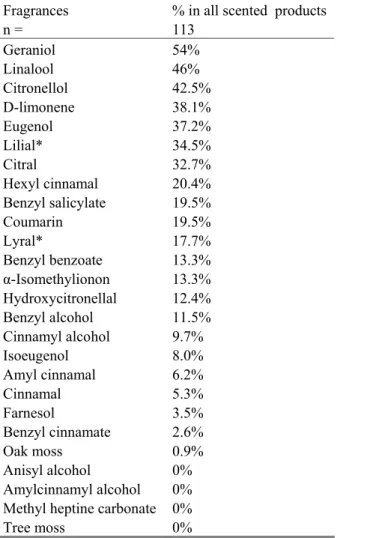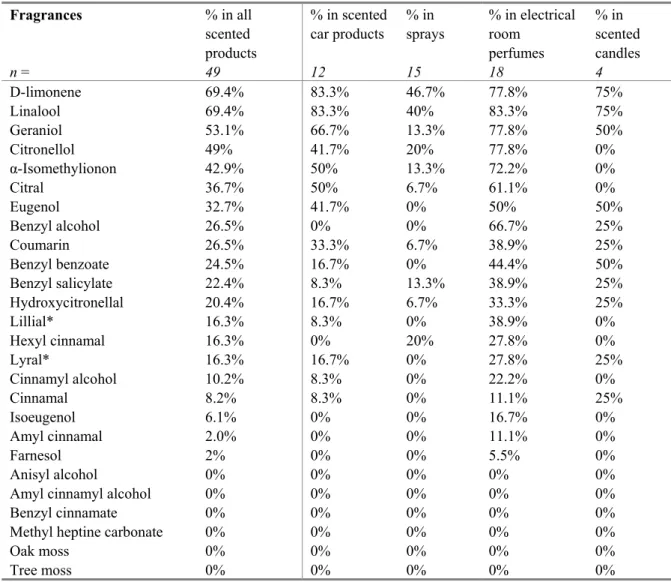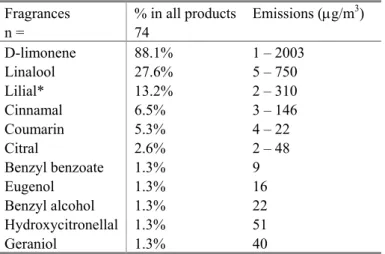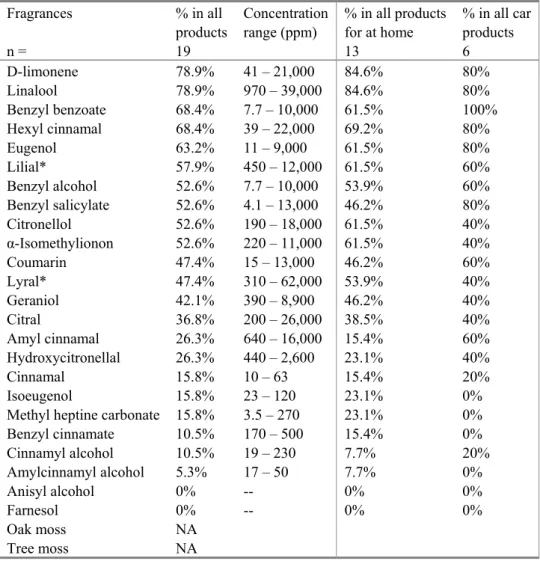Report 340301002/2009
J. Ezendam | J.D. te Biesebeek | S.W.P. Wijnhoven
The presence of fragrance
allergens in scented consumer
products
RIVM letter report 340301002/2009
The presence of fragrance allergens in scented consumer
products
J. Ezendam, Laboratory for Health Protection Research
J. D. te Biesebeek, Centre for Substances and Integrated Risk Assessment S. W. P. Wijnhoven, Centre for Substances and Integrated Risk Assessment
Contact: J. Ezendam GBO
Janine.Ezendam@rivm.nl
This investigation has been performed by order and for the account of Food and Consumer Product Safety Authority, within the framework of V340301 Allergene stoffen in geurproducten voor consumenten
© RIVM 2009
Parts of this publication may be reproduced, provided acknowledgement is given to the 'National Institute for Public Health and the Environment', along with the title and year of publication.
Contents
1 Background 4
2 Approach 5
3 Results 6
3.1 Fragrance allergens in scented products available on the Dutch market 6 3.2 Fragrance allergens in scented products: results from market surveys 8
4 Summary 10
5 Conclusion 11
References 13 Annex 1: Overview of fragrances identified by the SCCNFP 14
1
Background
There are several products on the market that contain fragrance chemicals, for example personal health care products (perfumes, creams, shampoos, toothpaste) and household products (room fresheners, cleaning products, detergents). Many different fragrance chemicals are used in these consumer products and for some fragrances it is known that they can cause contact dermatitis after skin contact.
Approximately 1-3% of the general population suffer from this type of allergy (Nielsen & Menne, 1992; Mortz et al., 2001; Nielsen et al., 2002; Dotterud, 2007; Dotterud & Smith-Sivertsen, 2007). In 1999 the EU Scientific Committee on Consumer and Non Food Products (SCCNFP, now known as the SCCS) has identified 24 fragrance chemicals that potentially could cause contact dermatitis. Of these fragrances, 13 are well-recognized contact allergens, whereas 11 are less well documented as contact allergens (SCCNFP, 1999) (summarized in Annex 1).Two botanical extracts, oak moss and tree moss, have been added to this list of 24 allergenic fragrances. According to EU legislation, labelling of these 26 fragrance allergens is mandatory when they are present in cosmetics (EU Directive 2003/15/EC, 2003).
Fragrances are not only present in cosmetics, such as creams and perfumes, but they are also used as ingredients in scented products intended to spread a pleasant smell in homes, cars and public buildings, i.e. room perfumes and air fresheners (Park et al., 2006). The exposure to fragrances in these products will be predominantly via inhalation, although dermal exposure to these products is possible as well. It is unknown if inhalation of fragrance allergens can lead to sensitization and subsequent induction of allergic symptoms in the respiratory tract. There are indications from an occupational setting that this is possible. A case report of a hairdresser describes the occurrence of occupational asthma caused by inhalation exposure to eugenol (Quirce et al., 2008). However, it is unknown if inhalation exposure to fragrance allergens present in consumer products can lead to respiratory allergies as well.
Within its responsibility to protect the safety of consumer products, the Dutch Food and Consumer Product Safety Authority (VWA) has initiated an project to gain more insight in the risks associated with the use of scented products. This project ultimately aims at developing a risk assessment strategy for these types of products. One important pillar for risk assessment is exposure assessment. This letter report will focus on this aspect. To gain insight in inhalation exposure to the 26 fragrance allergens a product inventory has been made of scented consumer products on the European market containing one or more of these fragrances.
2
Approach
For determination of the presence and concentrations of 26 allergenic fragrances in various products on the European market, different approaches were followed.
• Information on the fragrance products in scented products currently available on the Dutch market was obtained from the NVIC (Dutch National Poison Control Centre) database. The NVIC database contains information that was voluntarily provided by the manufacturer of the products. The list contains the names and CAS numbers of scented products for which inhalation exposure is likely to occur, together with ingredients and fractions of these ingredients. The database was searched for the 26 fragrance allergens by using their CAS numbers.
• The other source of information of this section is the website of Sara Lee (http://www.saralee-int.info/NL-NL/Our+Brands/AmbiPur). To our knowledge, Sara Lee is the only manufacturer of scented products with ingredient lists on their website.
• The information from the RIVM report “Allergens in consumer products” of Wijnhoven et al, (2008) was used to identify additional information from European market surveys, conducted in the last 10 years. Information of scented products from these BEUC (The European Consumers Organisation) and Danish EPA market surveys are reported in the current product inventory. • Also Google and Scopus searches were performed with the following terms: scented products,
fragrances, air fresheners etc. Unfortunately, this was without any useful result. Some Material Safety Data Sheets (MSDS) were found of scented products on the internet, however, no information on concentrations of the 26 allergenic fragrances was found in these sheets. In addition, websites of manufacturers of fragrances were found (for instance Givaudan), but these websites did not contain information on the type of products these fragrances were intended for.
3
Results
3.1
Fragrance allergens in scented products available on the Dutch market
Two databases were used to obtain information on the presence of fragrance allergens in scented products that can be purchased in the Netherlands. The data from the NVIC database are summarized in Table 1 and the publicly available data from Sara Lee (http://www.saralee-int.info/NL-NL/Our+Brands/AmbiPur) are summarized in Table 2.
Table 1 NVIC database: fragrances used in scented products
Fragrances % in all scented products
n = 113 Geraniol 54% Linalool 46% Citronellol 42.5% D-limonene 38.1% Eugenol 37.2% Lilial* 34.5% Citral 32.7% Hexyl cinnamal 20.4% Benzyl salicylate 19.5% Coumarin 19.5% Lyral* 17.7% Benzyl benzoate 13.3% α-Isomethylionon 13.3% Hydroxycitronellal 12.4% Benzyl alcohol 11.5% Cinnamyl alcohol 9.7% Isoeugenol 8.0% Amyl cinnamal 6.2% Cinnamal 5.3% Farnesol 3.5% Benzyl cinnamate 2.6% Oak moss 0.9% Anisyl alcohol 0% Amylcinnamyl alcohol 0% Methyl heptine carbonate 0%
Tree moss 0%
* INCI names Lilial: butylphenyl methylpropional and Lyral: hydroxyisohexyl-3-cyclohexene carboxaldehyde
The NVIC database contained 113 scented products. Of these, 48 were air freshners and room perfurmes and the other products were intended for steam baths or saunas. The NVIC data show that the most frequently used fragrances in scented products (>40% of the products) were geraniol, linalool and citronellol. Almost all fragrance allergens from the SCCP list are used as ingredients in the
products, with the exception of anisyl alcohol, amyl cinnamyl alcohol, methyl heptine carbonate and tree moss. The fragrances cinnamyl alcohol, isoeugenol, amyl cinnamal, cinnamal, farnesol, benzyl cinnamate and oak moss were not frequently used (<10% of the products) in these scented products.
Table 2 Most frequently used fragrances in scented products1
Fragrances % in all scented products % in scented car products % in sprays % in electrical room perfumes % in scented candles n = 49 12 15 18 4 D-limonene 69.4% 83.3% 46.7% 77.8% 75% Linalool 69.4% 83.3% 40% 83.3% 75% Geraniol 53.1% 66.7% 13.3% 77.8% 50% Citronellol 49% 41.7% 20% 77.8% 0% α-Isomethylionon 42.9% 50% 13.3% 72.2% 0% Citral 36.7% 50% 6.7% 61.1% 0% Eugenol 32.7% 41.7% 0% 50% 50% Benzyl alcohol 26.5% 0% 0% 66.7% 25% Coumarin 26.5% 33.3% 6.7% 38.9% 25% Benzyl benzoate 24.5% 16.7% 0% 44.4% 50% Benzyl salicylate 22.4% 8.3% 13.3% 38.9% 25% Hydroxycitronellal 20.4% 16.7% 6.7% 33.3% 25% Lillial* 16.3% 8.3% 0% 38.9% 0% Hexyl cinnamal 16.3% 0% 20% 27.8% 0% Lyral* 16.3% 16.7% 0% 27.8% 25% Cinnamyl alcohol 10.2% 8.3% 0% 22.2% 0% Cinnamal 8.2% 8.3% 0% 11.1% 25% Isoeugenol 6.1% 0% 0% 16.7% 0% Amyl cinnamal 2.0% 0% 0% 11.1% 0% Farnesol 2% 0% 0% 5.5% 0% Anisyl alcohol 0% 0% 0% 0% 0%
Amyl cinnamyl alcohol 0% 0% 0% 0% 0%
Benzyl cinnamate 0% 0% 0% 0% 0%
Methyl heptine carbonate 0% 0% 0% 0% 0%
Oak moss 0% 0% 0% 0% 0%
Tree moss 0% 0% 0% 0% 0%
1 Data are derived from the website of Sara Lee (http://www.saralee-int.info/NL-NL/Our+Brands/AmbiPur) * INCI names Lilial: butylphenyl methylpropional and Lyral: hydroxyisohexyl-3-cyclohexene carboxaldehyde
The Sara Lee database contained 49 scented products. When all scented products were analyzed, it was shown that the most frequently used fragrances (present in >40% of the products) were limonene, linalool, geraniol, citronellol and α-isomethylionon. The fragrances anisyl alcohol, amyl cinnamyl alcohol, benzyl cinnamate, methyl heptine carbonate, oak moss and tree moss were never used as ingredients in these products.
When the different product types were analyzed, it was shown that the distribution of the most
frequently fragrances differed slightly between the products. For instance in scented products that were intended for cars, the most frequently used fragrances were similar to those in all products, but in addition citral en eugenol were found in 50% of the car products. Furthermore, 9 of the 24 fragrances
were not used in car products and two car products were free from fragrance allergens. Remarkably, the distribution in sprays is very different from the other scented products. In sprays, limonene and linalool were used frequently, whereas other fragrances were only found in a limited number of products ≤ 20%). Furthermore, 16 of the 26 fragrance allergens were never reported to be used in sprays. One difference is that in sprays only a few fragrances were used per product and two sprays were free of allergens. In contrast, in electrical room perfumes the individual products contained many different fragrances per product. There was one product that even contained 15 of the 26 fragrance allergens. In electrical room perfumes the most frequently used fragrances were linalool, limonene, geraniol, citronellol, α-isomethylionon, benzyl alcohol and eugenol. The fragrances anisyl alcohol, amyl cinnamyl alcohol, benzyl cinnamate, methyl heptine carbonate, oak moss and tree moss were not used as ingredients in electrical room perfumes. Finally, in scented candles the most often used fragrances were limonene, linalool, geraniol and eugenol. Of the 26 fragrance allergens, only 11 were used in candles (n=4).
3.2
Fragrance allergens in scented products: results from market surveys
Table 3 summarizes the data from a study from the European Consumers Organisation (BEUC). They have measured emission levels of different chemicals, including 11 fragrances, from 74 air fresheners in indoor air (BEUC, 2005). The most often detected fragrance was D-limonene and emissions ranged from 1 – 2003 μg/m3. In almost 28% of the tested air fresheners, emission of linalool was detected, and concentrations ranged from 5-750 μg/m3. The other fragrances that were detected but in a limited number of products were: lilial, cinnamal, coumarin, citral, benzyl benzoate, eugenol, benzyl alchohol,hydroxycitronellal and geraniol.
Table 3 Fragrance emission by air fresheners
Fragrances n = % in all products 74 Emissions (μg/m3) D-limonene 88.1% 1 – 2003 Linalool 27.6% 5 – 750 Lilial* 13.2% 2 – 310 Cinnamal 6.5% 3 – 146 Coumarin 5.3% 4 – 22 Citral 2.6% 2 – 48 Benzyl benzoate 1.3% 9 Eugenol 1.3% 16 Benzyl alcohol 1.3% 22 Hydroxycitronellal 1.3% 51 Geraniol 1.3% 40
Data are derived from an European study from the BEUC (2005)* INCI names Lilial: butylphenyl methylpropional and Lyral: hydroxyisohexyl-3-cyclohexene carboxaldehyde.
The Danish Environmental Protection Agency (EPA) has performed a market survey in different stores and supermarkets that sell air fresheners for the home and the car (Pors & Fuhlendorff, 2003). A total of 19 products were selected and 6 of these were car products and 13 were products for use at home. In these products the presence and concentrations of 24 fragrance allergens were measured. The presence of oak moss and tree moss was not assessed in this study.
In Table 4, the results are summarized and the most frequently used fragrances (in >50% of the products) were D-limonene, linalool, benzyl benzoate, hexyl cinnamal, eugenol, lilial, benzyl alchohol and benzy salicylate. When the products intended for use at home or in the car were analyzed
separately, the distribution shifted slightly. In products for at home 22 of the 24 fragrance allergens were used, with the exception of anisyl alcohol and farnesol. In car products, 5 of the 24 fragrance allergens were not used, these products contained no anisyl alcohol, farnesol, benzyl cinnamate, methyl heptine carbonate, and isoeugenol.
In this study, the concentrations of the fragrances were measured as well. There was a large variation when the individual products were analyzed. In addition, some fragrance chemicals were used in higher concentrations than others. In general, cinnamal, isoeugenol, amyl cinnamal alcohol and methyl heptine carbonate were used in the lowest concentrations. The fragrances that were used in the highest
concentrations were (in weight % of a product) : lyral (6.2%), linalool (3.9%), citral (2.6%), hexyl cinnamal (2.2%), and D-limonene (2.1%).
Table 4 Most frequently used fragrances in air freshners from a Danish market survey
Fragrances n = % in all products 19 Concentration range (ppm) % in all products for at home 13 % in all car products 6 D-limonene 78.9% 41 – 21,000 84.6% 80% Linalool 78.9% 970 – 39,000 84.6% 80% Benzyl benzoate 68.4% 7.7 – 10,000 61.5% 100% Hexyl cinnamal 68.4% 39 – 22,000 69.2% 80% Eugenol 63.2% 11 – 9,000 61.5% 80% Lilial* 57.9% 450 – 12,000 61.5% 60% Benzyl alcohol 52.6% 7.7 – 10,000 53.9% 60% Benzyl salicylate 52.6% 4.1 – 13,000 46.2% 80% Citronellol 52.6% 190 – 18,000 61.5% 40% α-Isomethylionon 52.6% 220 – 11,000 61.5% 40% Coumarin 47.4% 15 – 13,000 46.2% 60% Lyral* 47.4% 310 – 62,000 53.9% 40% Geraniol 42.1% 390 – 8,900 46.2% 40% Citral 36.8% 200 – 26,000 38.5% 40% Amyl cinnamal 26.3% 640 – 16,000 15.4% 60% Hydroxycitronellal 26.3% 440 – 2,600 23.1% 40% Cinnamal 15.8% 10 – 63 15.4% 20% Isoeugenol 15.8% 23 – 120 23.1% 0%
Methyl heptine carbonate 15.8% 3.5 – 270 23.1% 0%
Benzyl cinnamate 10.5% 170 – 500 15.4% 0% Cinnamyl alcohol 10.5% 19 – 230 7.7% 20% Amylcinnamyl alcohol 5.3% 17 – 50 7.7% 0% Anisyl alcohol 0% -- 0% 0% Farnesol 0% -- 0% 0% Oak moss NA Tree moss NA
Data are derived from market survey conducted by the Danish EPA (Pors and Fuhlendorff, 2003)* INCI names Lilial: butylphenyl methylpropional and Lyral: hydroxyisohexyl-3-cyclohexene carboxaldehyde. NA: not assessed.
4
Summary
This letter report provides information on the use of 26 fragrance allergens that are known as contact allergens, in scented products.
• In scented products that are available on the Dutch market the majority of the 26 fragrances are used as ingredients. Anisyl alcohol, amyl cinnamyl alcohol, methyl heptine carbonate, and tree moss were not used as ingredients.
• In the Danish market survey it was shown that anisyl alcohol and farnesol could not be detected in any of the scented products. In this study, the presence of the botanical extracts oak moss and tree moss was not assessed.
• There are some differences in the most frequently used fragrances per product type, but in general it can be concluded that the most frequently used fragrances in products for the Dutch market are D-limonene, linalool, geraniol, and citronellol. Fragrance allergens that are less frequently used in scented products are benzyl cinnamate, cinnamyl alcohol, cinnamal, isoeugenol, methyl heptine carbonate and oak moss
• The most frequently used fragrances in the Danish market survey were also D-limonene and linalool. In addition, benzyl benzoate, hexyl cinnamal and eugenol were detected in the majority of Danish products. Apparently, some differences exist between the products on the Dutch and the Danish market. However, it should be noted that the number of products in the Danish study was much lower than in the two Dutch databases, which might explain the differences.
• The Danish EPA study provides data on the levels of fragrances that are present in these products and shows that large differences exist, dependent on the product and the fragrance. The lowest levels were found for amyl cinnamyl alcohol, cinnamyl alcohol, cinnamal, isoeugenol, methyl heptine carbonate, benzyl cinnamate. The highest levels were found for lyral, linalool, citral, hexyl cinnamal and D-limonene.
• The BEUC study measured emissions and shows that D-limonene is emitted from the majority of scented products. Other fragrances that were emitted, but by much less products, were linalool, lilial, cinnamal, coumarin and citral. Only a few products emitted detectable levels of benzyl benzoate, eugenol, benzyl alcohol, hydroxitronellal and geraniol.
5
Conclusion
From this product inventory it can be concluded that exposure to fragrance allergens via inhalation is possible for the majority of the 26 fragrances listed by the SCCS. The most frequently used fragrances in scented products are also frequently used as ingredients in other consumer products, for example in cosmetics, i.e. D-limonene, linalool, lilial and geraniol. The potency of these fragrances to induce contact dermatitis is weak and although they are present in many consumer products, these fragrances do not often cause contact dermatitis. The product inventory also shows that strong and moderate skin sensitizers, such as isoeugenol, methyl heptine carbonate and cinnamal, are not frequently used as ingredients in scented products. These fragrances are also not often used in cosmetics, but for instance isoeugenol and cinnamal are important contact allergens. Hence, the skin sensitizing potency is an important determinant in the risk on developing contact dermatitis.
It is currently unknown whether skin sensitizing potency can be used to predict the hazard on respiratory sensitization. In this project, experiments have been performed to assess the hazard of inhalation of fragrances; these data will be published separately this year. Furthermore, in this project it will be investigated in experimental animal models, if inhalation of fragrance allergens can induce respiratory allergic manifestations in people with an existing fragrance allergy, due to skin contact. Ultimately, the information on hazard identification and human exposure will be used to develop a strategy to evaluate the risk of scented consumer products.
Acknowledgements
We thank Dr. Ronald de Groot from NVIC for providing the information on scented products from the NVIC database. We thank Dr. Jacqueline van Engelen and Prof. Dr. Henk van Loveren for critical reading the letter report.
References
1. BEUC (2005) The European Consumers Organisation. Emission of chemicals by air fresheners - Tests on 74 consumer products sold in Europe
2. Dotterud LK (2007) The prevalence of allergic contact sensitization in a general population in Tromso, Norway. Int J Circumpolar Health 66, 328-334.
3. Dotterud LK & Smith-Sivertsen T (2007) Allergic contact sensitization in the general adult population: a population-based study from Northern Norway. Contact Dermatitis 56, 10-15. 4. EU Directive 2003/15/EC D (2003) Directive 2003/15/EC of the European Parliament and of the
Council of 27 February 2003 amending Council Directive 76/768/EEC on the approximation of the laws of the Member States relating to cosmetic products. Official Journal of the EuropeanUnion 2003: L66, 26–35.
5. Mortz CG, Lauritsen JM, Bindslev-Jensen C & Andersen KE (2001) Prevalence of atopic dermatitis, asthma, allergic rhinitis, and hand and contact dermatitis in adolescents. The Odense Adolescence Cohort Study on Atopic Diseases and Dermatitis. Br J Dermatol 144, 523-532. 6. Nielsen NH, Linneberg A, Menne T, Madsen F, Frolund L, Dirksen A & Jorgensen T (2002)
Incidence of allergic contact sensitization in Danish adults between 1990 and 1998; the Copenhagen Allergy Study, Denmark. Br J Dermatol 147, 487-492.
7. Nielsen NH & Menne T (1992) Allergic contact sensitization in an unselected Danish population. The Glostrup Allergy Study, Denmark. Acta Derm Venereol 72, 456-460.
8. Park MVDZ, Janssen PJCM & Raaij MTM (2006) Risk assessment for scented products: a pre-study RIVM report 320105002.
9. Pors J & Fuhlendorff R (2003) Mapping of chemical substances in air fresheners and other fragrance liberating products. . Survey of chemical substances in consumer products. Survey no. 30.
10. Quirce S, Fernández-Nieto M, Pozo Vd, Sastre B & Sastre J (2008) Occupational asthma and rhinitis caused by eugenol in a hairdresser. Allergy 63, 137-138.
11. SCCNFP (1999) Opinion concerning fragrance allergy in consumers. SCCNFP/0017/98. 12. Wijnhoven S.W.P, Ezendam J., Schuur A.G., Van Loveren H., & Van Engelen J.G.M (2009)
Annex 1: Overview of fragrances identified by the SCCNFP
1Fragrances - most frequently reported as consumer allergens
Common name CAS no
Amyl cinnamal 122-40-7 Amylcinnamyl alcohol 101-85-9 Benzyl alcohol 100-51-6 Benzyl salicylate 118-58-1 Cinnamyl alcohol 104-54-1 Cinnamal 104-55-2 Citral 5392-40-5 Coumarin 91-64-5 Eugenol 97-53-0 Geraniol 106-24-1 Hydroxycitronellal 107-75-5 Hydroxymethylpentyl-cyclohexenecarboxaldehyde (HMPCC) 31906-04-4 Isoeugenol 97-54-1
Fragrances - Less frequently reported as consumer allergens
Common name CAS no
Anisyl alcohol 105-13-5 Benzyl benzoate 120-51-4 Benzyl cinnamate 103-41-3 Citronellol 106-22-9 Farnesol 4602-84-0 Hexyl cinnamaldehyde 101-86-0 Lilial 80-54-6 d-Limonene 5989-27-5 Linalool 78-70-6
Methyl heptine carbonate 111-12-6
3-Methyl-4-(2,6,6-trimethyl-2-cyclohexe-1-yl)-3-buten-2-one (= γ-methylionone)
127-51-5
RIVM
National Institute for Public Health and the Environment P.O. Box 1



